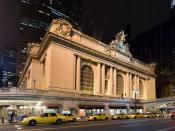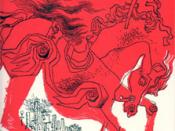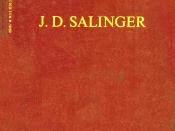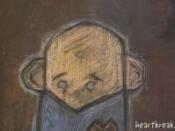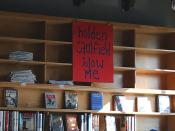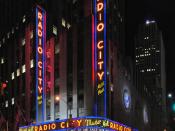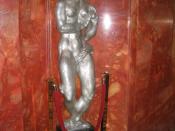Movie Proposal: The Catcher in the Rye Vina Ku Iverson/Racey Per. 7, 8 To the Producer: The Catcher in the Rye, a contemporary novel by J.D. Salinger, is a thought-provoking, fascinating look at society's values and issues in the 1950's. This book would make an excellent transition to film because it is full of both action and implication. It focuses on a four-day period of time in the life of a sixteen-year-old cynic with emotional problems. The book follows Holden Caulfield as he struggles with others and himself to find his way through the "phoniness" and disillusionment involved in his adolescent life. These struggles essentially make up the novel, occurring during a long "flashback" of the four days as he relates them to a psychoanalyst. It would make a brilliant movie because it is written with so much detail, so many pictures that would be beautifully expressed through visual representation.
Not only that, but the novel possesses substance, providing a subjective view of the superficiality of modern life, which is represented by the world Salinger creates around Holden.
Summary: The movie would be named after the novel it is based on, and would attempt to follow the exact storyline. Pencey Prep, the private school that Holden attended would not have to be in Pennsylvania, but somewhere resembling the area. Most of the city incidents would actually be filmed in New York City. Of course, certain streets would have to be singled out, and the costuming and cars, etc., would have to resemble1950's New York in order to fit the time period.
The movie would be narrated by Holden, who would stop talking at times to allow focus on the flashbacks taking place in what would then seem like present tense. Much of the narration does not need to be put into dialogue because Holden spends a great deal of time in his descriptions of what is going on around him. This aspect of the book would have to be carried out carefully and precisely by actors with the right kind of talent (see Characters/Acting) in order to make the movie successful in capturing Salinger's exact tones and concepts.
Note: the main objective of the movie is to present The Catcher in the Rye in visual format. This means to follow as closely as possible to the original plot, dialogue, settings, etc. as written in the book unless truly impossible. The movie should reflect the intentions of J.D. Salinger and also incorporate the themes expressed in the novel (i.e., hypocrisies and phonies in everyday life, the search for a place to belong, isolation and wearing masks). If possible, the author should be contacted for opinions and criticism throughout the filming of the movie.
The beginning of the movie could or could not be modified from the beginning of the book; either way would still appropriately capture the atmosphere of the psychoanalyst and Holden. One way to begin is by actually showing Holden lying in a psychoanalyst's office, where he begins his narration. The camera would then fade into Pencey Prep, with Holden standing atop Thomsen Hill. Another approach could just be to begin directly with the scene on the hill, with Holden voicing over the picture.
Of course, not every scene could have narration. Otherwise the movie would be unrealistic. Some of the thoughts that run through Holden's head would have to become dialogue, for example, Holden would mumble "Phony" under his breath while talking to certain characters.
Locations: All of the scenes occurring at Pencey would be filmed at another prep school resembling the descriptions given by Holden throughout the book. ("...Way the hell up on top of Thomsen Hill, right next to this crazy cannon that was in the Revolutionary War...You could see the whole [football] field from there..."-The Catcher in the Rye, p.2) One of the more grotesque scenes would be the suicide of James Castle. This is a critical scene because Holden tells the reader about it after the incident in Mr.Antolini's apartment, depicting Holden's sudden unwillingness to judge him. It can be filmed well using stuntmen and technology to recreate the jump from the window and the death. The moment Mr.Antolini approaches the body afterwards should be caught on camera to emphasize his character.
The scenes in Mr.Antolini's apartment, along with the scenes in the hotel room with the prostitute and the bars in the other hotels, should be shot in the appropriate hotels in New York City. A seedy, run-down hotel in a bad neighborhood named something like E-Z Rest Hotel would be appropriate as a substitute for the Edmont Hotel. This is where Holden stayed and had the prostitute incident in, along with the experiences at the bar downstairs. A nice, upscale hotel like the Ritz would be appropriate for the Biltmore Hotel, and the meeting place for Holden and Sally Hayes. Other settings might need a fake set because finding actual places resembling the time period would be hard to do, but should be done if at all possible to make the movie as good as it can be. Some locations would be the theater Holden and Sally go to, the Caulfields' apartment, etc. Certain settings that are preexisting in New York city, such as Radio City Music Hall, the museums, Grand Central Station and Central Park should be used as they are, unless modifications would be necessary to make the areas look like they did in the 1950's.
The rest home, whether used in both the beginning and end or just in the end, would be in an unspecific location, but obviously somewhere in California. The room Holden is in with the psychoanalyst would be sunny, but not too bright, and the psychoanalyst would never actually be seen. All that is visible is Holden, lying on a couch, talking.
The majority of the book takes place in New York City, as before mentioned. The city must be filmed carefully, because it is not only a backdrop for the book, but has an essential purpose. The nameless people of the city that Holden observes throughout the book are actually symbolic for the city's character itself. Holden sees and has contact with various unnamed characters throughout the city, like the unusual cab drivers, and the little boy humming Burns' song that Holden misheard, "If a body catch a body coming through the rye". These people all represent the different aspects of the City, and of urbanization during the beginning of the Atomic Age.
Characters/Acting: Because of the numerous characters Holden encounters, not every single character mentioned will be actually played by an actor, or even seen in the film, but the majority will be. Most of the small roles are vital however, such as the characters mentioned above. All of the shortly mentioned characters are placed into Holden's world for a reason, so they must be portrayed. The small characters give insight to Holden's personality, as well as the personality of the "character" played by the urban world. Such interactions between them, like the one between Horowitz, the second cab driver, and Holden, about the ducks in Central Park are used as insight to Holden's personality. Holden asks the cabby about something that would seem trivial to others, and the cabby responds in a dramatic, rude manner, almost comedic, and stereotypical of urban dwellers ("Who's ignoring it? Nobody's ignoring it!"-p.82). The personality displayed by Horowitz is another indication that the novel is not only about Holden and his adventures, but also of the world he lives in.
Characters must be played by actors with a certain similarity to the character itself, whether it is by their physical appearance, the way they speak or otherwise. Holden is a 16 year-old boy, and so he should be played by a boy who looks no older than that. The boy should be rather thin, but with muscles, and have a face with character. Holden is to be played with intensity, anger, sadness, but also have a loving nature, all of which he displays throughout the novel, whether obviously or inconspicuously. The novel accurately describes most of the other characters, because of Holden's observant nature. All details given by Holden should be carried out accordingly.
The movie would be best directed by Stephen Spielberg, because of his ability to keep movies true to nature, and still produce a compelling story. This would be an excellent project for him because the objective of the film is to do exactly what Spielberg did with movies such as Schindler's List and Saving Private Ryan: to take a story, fiction or non-, and portray it as a emotionally moving picture, while keeping it true to the original vision.
The movie spin-off of The Catcher in the Rye should accurately represent the novel written by J.D. Salinger. The budget for the film should be whatever is deemed necessary by the director to make the movie as realistic and well done as possible. The budget should not be a consideration because it would hinder the quality of the film and therefore not allow it to live up to the wonderful the novel could have as a film. If carried out well, this film would be a huge success.
